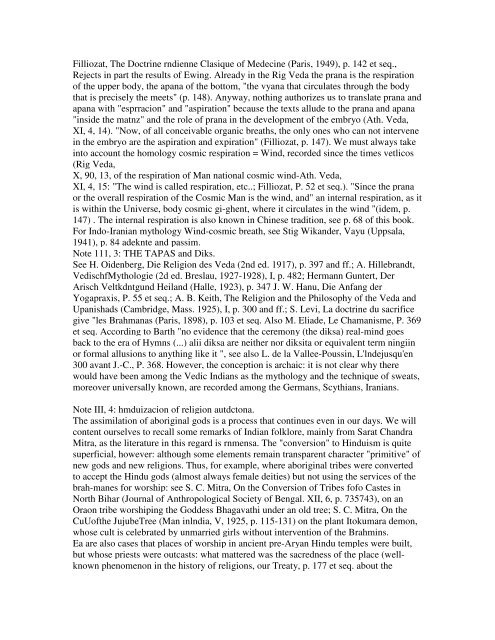Mircea Eliade YOGA IMMORTALITY AND ... - Brihaspati.net
Mircea Eliade YOGA IMMORTALITY AND ... - Brihaspati.net
Mircea Eliade YOGA IMMORTALITY AND ... - Brihaspati.net
You also want an ePaper? Increase the reach of your titles
YUMPU automatically turns print PDFs into web optimized ePapers that Google loves.
Filliozat, The Doctrine rndienne Clasique of Medecine (Paris, 1949), p. 142 et seq.,<br />
Rejects in part the results of Ewing. Already in the Rig Veda the prana is the respiration<br />
of the upper body, the apana of the bottom, "the vyana that circulates through the body<br />
that is precisely the meets" (p. 148). Anyway, nothing authorizes us to translate prana and<br />
apana with "esprracion" and "aspiration" because the texts allude to the prana and apana<br />
"inside the matnz" and the role of prana in the development of the embryo (Ath. Veda,<br />
XI, 4, 14). "Now, of all conceivable organic breaths, the only ones who can not intervene<br />
in the embryo are the aspiration and expiration" (Filliozat, p. 147). We must always take<br />
into account the homology cosmic respiration = Wind, recorded since the times vetlicos<br />
(Rig Veda,<br />
X, 90, 13, of the respiration of Man national cosmic wind-Ath. Veda,<br />
XI, 4, 15: "The wind is called respiration, etc..; Filliozat, P. 52 et seq.). "Since the prana<br />
or the overall respiration of the Cosmic Man is the wind, and" an internal respiration, as it<br />
is within the Universe, body cosmic gi-ghent, where it circulates in the wind "(idem, p.<br />
147) . The internal respiration is also known in Chinese tradition, see p. 68 of this book.<br />
For Indo-Iranian mythology Wind-cosmic breath, see Stig Wikander, Vayu (Uppsala,<br />
1941), p. 84 adeknte and passim.<br />
Note 111, 3: THE TAPAS and Diks.<br />
See H. Oidenberg, Die Religion des Veda (2nd ed. 1917), p. 397 and ff.; A. Hillebrandt,<br />
VedischfMythologie (2d ed. Breslau, 1927-1928), I, p. 482; Hermann Guntert, Der<br />
Arisch Veltkdntgund Heiland (Halle, 1923), p. 347 J. W. Hanu, Die Anfang der<br />
Yogapraxis, P. 55 et seq.; A. B. Keith, The Religion and the Philosophy of the Veda and<br />
Upanishads (Cambridge, Mass. 1925), I, p. 300 and ff.; S. Levi, La doctrine du sacrifice<br />
give "les Brahmanas (Paris, 1898), p. 103 et seq. Also M. <strong>Eliade</strong>, Le Chamanisme, P. 369<br />
et seq. According to Barth "no evidence that the ceremony (the diksa) real-mind goes<br />
back to the era of Hymns (...) alii diksa are neither nor diksita or equivalent term ningiin<br />
or formal allusions to anything like it ", see also L. de la Vallee-Poussin, L'lndejusqu'en<br />
300 avant J.-C., P. 368. However, the conception is archaic: it is not clear why there<br />
would have been among the Vedic Indians as the mythology and the technique of sweats,<br />
moreover universally known, are recorded among the Germans, Scythians, Iranians.<br />
Note III, 4: hmduizacion of religion autdctona.<br />
The assimilation of aboriginal gods is a process that continues even in our days. We will<br />
content ourselves to recall some remarks of Indian folklore, mainly from Sarat Chandra<br />
Mitra, as the literature in this regard is rnmensa. The "conversion" to Hinduism is quite<br />
superficial, however: although some elements remain transparent character "primitive" of<br />
new gods and new religions. Thus, for example, where aboriginal tribes were converted<br />
to accept the Hindu gods (almost always female deities) but not using the services of the<br />
brah-manes for worship: see S. C. Mitra, On the Conversion of Tribes fofo Castes in<br />
North Bihar (Journal of Anthropological Society of Bengal. XII, 6, p. 735743), on an<br />
Oraon tribe worshiping the Goddess Bhagavathi under an old tree; S. C. Mitra, On the<br />
CuUofthe JujubeTree (Man inlndia, V, 1925, p. 115-131) on the plant Itokumara demon,<br />
whose cult is celebrated by unmarried girls without intervention of the Brahmins.<br />
Ea are also cases that places of worship in ancient pre-Aryan Hindu temples were built,<br />
but whose priests were outcasts: what mattered was the sacredness of the place (wellknown<br />
phenomenon in the history of religions, our Treaty, p. 177 et seq. about the







